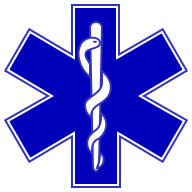Advanced cardiac life support
| Advanced cardiac life support | |
 | |
|---|---|
| Star of Life |
Editor-In-Chief: C. Michael Gibson, M.S., M.D. [1]
Synonyms and keywords: ACLS
Overview
Advanced cardiac life support or (ACLS) refers to a set of clinical interventions for the urgent treatment of cardiac arrest and other life threatening medical emergencies, as well as the knowledge and skills to deploy those interventions.[1] Extensive medical knowledge and rigorous hands-on training and practice are required to master ACLS. Only qualified health care providers (e.g. physicians, paramedics, nurses, respiratory therapists and other specially trained health care providers) can provide ACLS, as it requires the ability to manage the patient's airway, initiate IV access, read and interpret electrocardiograms, and understand emergency pharmacology.
General consideration
- ACLS is an extension of BLS. Some health professionals, or even lay rescuers, may be trained in basic life support (BLS), especially cardiopulmonary resuscitation or CPR.
- When a sudden cardiac arrest occurs, immediate CPR is a vital link in the chain of survival. Another important link is early defibrillation, which has improved greatly with the widespread availability of AEDs. It often starts with analysing patient's heart rhythms with a manual defibrillator.
- In contrast to an AED in BLS, where the machine decides when and how to shock a patient, the ACLS team leader makes those decisions based on rhythms on the monitor and patient's vital signs.
- The next steps in ACLS are insertion of intravenous (IV) lines and placement of various airway devices.
- Commonly used ACLS drugs, such as epinephrine and atropine, are then administered. At this time, the ACLS personnel quickly search for possible causes of cardiac arrest (e.g., a heart attack, drug overdose, or trauma).
- Based on their diagnosis, more specific treatments are given. These treatments may be medical such as IV injection of an antidote for drug overdose, or surgical such as insertion of a chest tube for those with tension pneumothoraces or hemothoraces.
- While the above mentioned ACLS steps are being carried out, it is crucial to continue chest compression with minimal interruptions. This point is emphasized repeately in the new ACLS guidelines (see below)
- As the new guidelines acknowledge, only the basic interventions of CPR and early defibrillation have been shown to improve survival from cardiac arrest.[2]
- The new Guidelines were published in December 2005 and may be found in Circulation
[3]. The major source for ACLS courses and textbooks in the United States is the American Heart Association; in Europe, it is the European Resuscitation Council (ERC). An ACLS Provider Manual reflecting the new Guidelines is now available.
- The American College of Emergency Physicians is also a respected source of credentialing and training in ACLS
Main algorithm
ALS presumes that basic life support (bag-mask administration of oxygen and chest compressions) are administered.
The main algorithm of ALS, which is invoked when actual cardiac arrest has been established, relies on the monitoring of the electrical activity of the heart on a cardiac monitor. Depending on the type of cardiac arrhythmia, defibrillation is applied, and medication is administered. Oxygen is administered and endotracheal intubation may be attempted to secure the airway. At regular intervals, the effect of the treatment on the heart rhythm, as well as the presence of cardiac output, is assessed.
Medication that may be administered may include adrenaline (epinephrine), amiodarone, atropine, bicarbonate, calcium, potassium and magnesium. Saline or colloids may be administered to increase the circulating volume.
While CPR is given (either manually, or through automated equipment such as AutoPulse), members of the team consider eight forms of potentially reversible causes for cardiac arrest, commonly abbreviated as "4H4T":
- Hypoxia (low oxygen levels in the blood)
- Hypovolemia (low amount of circulating blood, either absolutely due to blood loss or relatively due to vasodilation)
- Hyperkalemia or hypokalemia (disturbances in the level of potassium in the blood) and related disturbances of calcium or magnesium levels and hypoglycemia (low glucose levels).
- Hypothermia (body temperature not maintained)
- Tension pneumothorax (tear in the lung leading to collapsed lung and twisting of the large blood vessels)
- Tamponade (fluid or blood in the pericardium, compressing the heart)
- Toxic and/or therapeutic (chemicals, whether medication or poisoning)
- Thromboembolism and related mechanical obstruction (blockage of the blood vessels to the lungs or the heart by a blood clot or other material)
The advanced cardiac life support cases
Ventricular fibrillation
Ventricular fibrillation/Pulseless Ventricular tachycardia
Unstable tachycardia
Stable tachycardia
Pulseless electrical activity
Asystole
Bradycardia
Acute coronary syndrome
Acute stroke
Respiratory arrest
Other conditions
ALS also covers various conditions related to cardiac arrest, such as cardiac arrhythmias (atrial fibrillation, ventricular tachycardia), poisoning and effectively all conditions that may lead to cardiac arrest if untreated, apart from the truly surgical emergencies (which are covered by Advanced Trauma Life Support).
References
- ↑ ACLS: Principles and Practice. p. 1. Dallas: American Heart Association, 2003. ISBN 0-87493-341-2.
- ↑ Stiell IG, Wells GA, Field B, et al. Advanced cardiac life support in out-of-hospital cardiac arrest. N Engl J Med 2004; 351:647-56.Article
- ↑ Circulation 112: Issue 24 Supplement; December 13, 2005 Issue.
External links
- British Heart Foundation includes good glossary, and details of heart health
- American Heart Association CPR and Emergency Cardiovascular Care
- UK Resuscitation Council
- European Resuscitation Council includes the new European 2005 guidelines